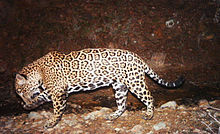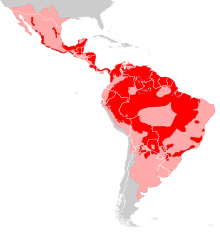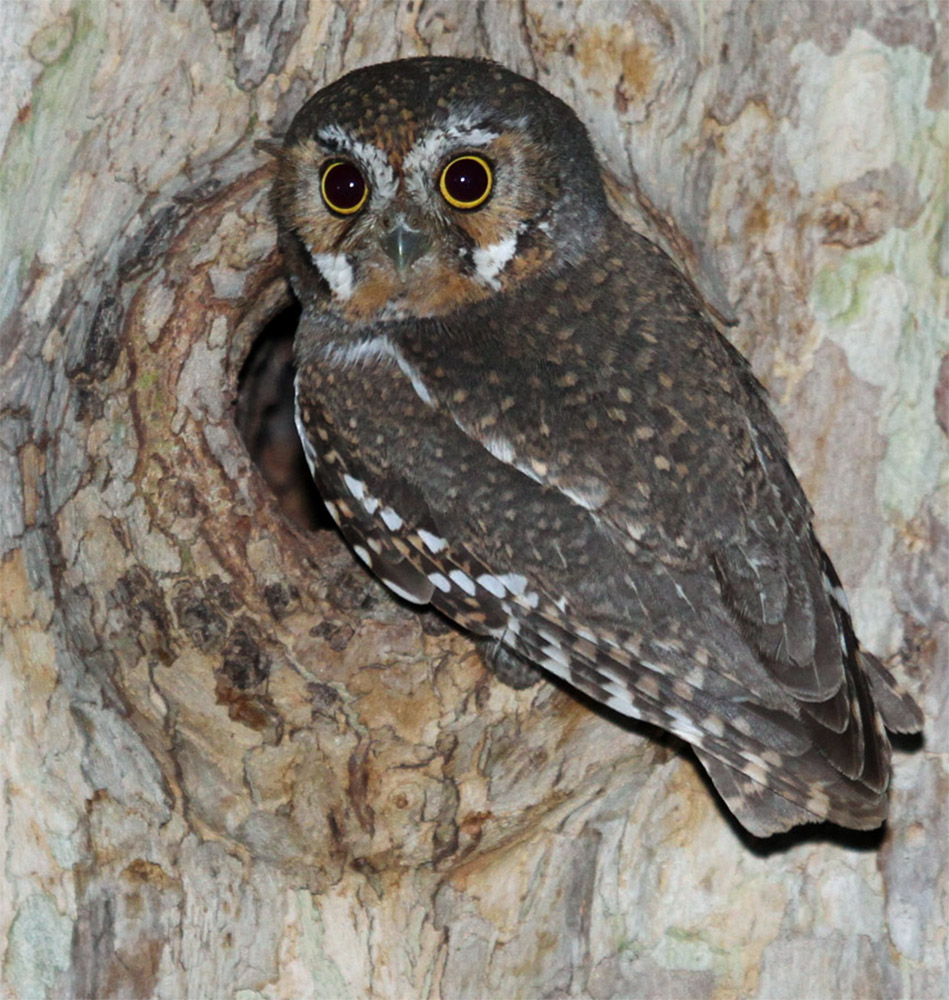User:Lee yun betty/sandbox/Biodiversity
Animal
[edit | edit source]Elf Owl
[edit | edit source]Habitat
[edit | edit source]* Mostly seen looking out of a hole in a Saguaro cactus
* Mountains reaching elevations of up to about 6000ft
* deserts
* Migrates to Mexico when it gets too cold because insects will not come out in the cold
* The map to the right shows its habitat through at the year, yellow: summer, blue: winter, purple: year round ----->
Diet
[edit | edit source]* Feeds on insects and other arthropods
* In summer. Feeds on moths, beetles and crickets
* Also feeds on scorpions and spiders
* Rarely eats lizards and other small vertebrates
Life Span
[edit | edit source]* Lives 3-6 years
* With care and special protection, can live up to 6-10 years
Facts and Physique
[edit | edit source]* The smallest Owls in the World
* Less than six inches tall
* Weights one to one and a half ounces
* When captured by a pray of sorts, the Elf Owl plays dead until all danger has cleared
* Not aggressive
Jaguar (Panthera onca)
[edit | edit source]

Panthera onca otherwise known as the jaguar is a type of cat that is found across the Americas: Southwestern United States, Mexico, Central America, south to Paraguay, and northern Argentina. The jaguar belongs to family Felidae, mammal, in the order Carnivora, carnivorous with teeth adapted for flesh-eating. The jaguar is the third-largest cat in the world surpassed by the lion and the tiger. The jaguar is classified as Near Threatened by the International Union for Conservation of Nature, which suggests that the jaguar may be threatened with extinction soon. It doesn't quite qualify for threatened species since the population has not yet decreased dramatically in a short period. Although, the jaguar's population is constantly decreasing due to various factors.
"El Jefe"
[edit | edit source]Due to the deterioration of their habitat caused by hunting, buildings, and conservation of livestock. There is only one known jaguar in the United States. This jaguar is known as "El Jefe", he resides in the Santa Rita Mountains near Tucson Arizona. "El Jefe" was first recorded in November 2011, by cameras for the Jaguar Survey and Monitoring Project by the University of Arizona. El Jefe has made constant appearances throughout the years up until 2018. It is believed that he has traveled back to Mexico in search of a mate.
Habitat
[edit | edit source]
The jaguar lives throughout the Americas in a wide variety of habitats. They prefer dense, tropical forests and rainforest which provide a large amount of coverage. Jaguars are also found in scrubland, reed thickets, coastal forest, swamps, thickets, pampas grasslands, and mountain scrub areas. In northern Mexico and the southwestern United States, jaguars are found in oak woodlands, mesquite thickets, and riparian woodlands. Jaguar's habitats require three main characteristics to support their diet and lifestyle: water, dense coverage, and prey.
Diet
[edit | edit source]Jaguars are known carnivores they have a wide variety of prey: birds, mammals, reptiles, fish. One of their main prey consists of large animals and livestock, they tend to eat the heart, liver, and spleen first; they don't ingest the intestines. Their daily consumption is around 1.2-1.5 kilograms per day. They usually hunt at night and mostly on the ground. There are times when it climbs up trees in order to hide from their prey and attack from above. Their large teeth and powerful jaws allow them to instantly kill their prey and drag them to a secluded spot where they can eat. In this area, El Jefe has been known to eat prey common in the Santa Rita Mountains: white-tailed deer, skunks (except for their ends), and other small, slow animals that allow them to prey on.
Facts
[edit | edit source]- Size: 5 to 7 feet
- Live 12 to 15 years
- Weight: 100 to 250 pounds
- They are cats, but not afraid of water
- They see six times better than humans in dar conditions
- Hunted to extinction in the United States during the 1940s
Threats
[edit | edit source]The jaguar is classified under "Near Threatened" species internationally. In the United States under the Endangered Species Act, it is classified as endangered. The last verified jaguar in this area was killed by a hunter in 1963. Jaguars face many threats either directly or towards their habitat, disrupting their life and ability to maintain alive. The main threat to jaguars is humans. Humans have hunted these mammals for a long time and various reasons: trophies, fur, and protection of livestock. Jaguar habitats have also been harmed by burning their homeland in order to place buildings. El Jefes habitat is currently endangered due to Trump's border wall and the copper mine.
Coyote
[edit | edit source]The Coyote (Canis latrans) is a canine that lives in North America, roaming the plains, deserts, mountains, and forests. Coyotes are primarily carnivorous, they prey on rabbits, birds, deer, reptiles, fish, invertebrates, and amphibians. Occasionally, they eat fruits and vegetables. Humans are considered to be the biggest threat to coyotes, followed by gray wolves and cougars. The average male weighs 8 to 20 kg and the average females weigh 7 to 18 kg. The hair of this animal varies depending on where they are geographically located. The predominant color of their hair is fulvous or grey and red.
Habitat
[edit | edit source]Coyotes live in North America where they roam the mountains, plains, forests, and deserts of the United States, Mexico, and Canada. Although coyotes are known to easily adapt to different habitats, they typically prefer to live in open areas like deserts and prairies. As humans take more and more land, coyotes can also be found living around large cities, where they are beginning to adapt.
Diet
[edit | edit source]Although they are thought to be only meat eaters, coyotes are actually omnivores--eating vegetation and meat. Generally, coyotes are scavengers and are predators of small prey, but occasionally, they shift to large prey. Coyotes will prey on birds, rabbits, reptiles, fish, deer, invertebrates, and amphibians. Some fruits and grains they feed on include, berries, apples, peaches, watermelon, carrots, beans, wheat, and corn. Most of the time coyotes hunt alone, but when hunting for large prey such as deer, they will hunt in packs. For those that live in large cities, coyotes will normally kill pets and livestock, eat pet food, or garbage.
Life Span
[edit | edit source]The average lifespan of a coyote is six to eight years in the wild, while those in captivity can live twice as long ranging from thirteen to fifteen years. They are affected by a variety of diseases and parasites which include, intestinal worms, heartworms, fleas, and ticks. They may also be affected by the parvovirus, canine distemper, and mange. However, humans are considered to be the greatest threat to humans. In rural areas, the major cause of death is due to trapping and hunting, while in urban areas, the cause of death is primarily automobiles. There has been an average of automobile collisions from 40 to 70 percent each year.
- REDIRECT [[1]]
Importance
[edit | edit source]Coyotes play an important ecological role in the environment by helping maintain healthy ecosystems and boosting biodiveristy. As they are the top carnivores in some ecosystems, they regulate mesocarnivore populations, which include, foxes, skunks, opossums, and raccoons.
Facts
[edit | edit source]- Coyotes can run up to 40 miles an hour.
- Coyote pups are born blind.
- Coyotes are nocturnal.
- Coyotes are monogamous and only have one mate for the rest of their life.
- Coyotes have few natural predators. They include mountain lions, wolves, and bears.
Sonoran Pronghorn Antelope (Antilacapra Americana Sonoriensis)
[edit | edit source]
Facts
[edit | edit source]- Subspecies of the Pronghorn
- Endangered
- Lifespan of 10-12 years
- Can reach speeds up to 60mph
- Great eyesight
Habitat
[edit | edit source]The Sonoran Pronghorn is endemic to the Sonoran Desert favoring its broad valleys. Before it became endangered the Sonoran Pronghorn was primarily found in Southwest Arizona and Northern parts of Sonora, Mexico like Hermosillo. It wasn't until 2012 that the Sonoran Pronghorn was reintroduced into the flatlands of Southwest Arizona and Mexico.
Diet
[edit | edit source]The diet of the the Sonoran Pronghorn consists of herbs, cacti, and desert grasses. Their rudiment stomachs allow them to digest rough textured foods, like the ones listed before. Along with the ability to digest these foods, their stomachs allow for better water retention.
Threats
[edit | edit source]Elements that contribute to the Sonoran Pronghorns being an endangered subspecies are predators, climate and human disturbance. Some predators of Pronghorns include cougars, wolves, coyotes, and bobcats. Climate and climate change can take part in threatening the Sonoran Pronghorn population with long lasting droughts. Human disturbances such as roads, fences, water developments, mining disturbances and other human interactions also play a part in the disappearance of the Sonoran Pronghorn.
Variable Sandsnake (Chilomeniscus stramineus)
[edit | edit source]http://www.reptilesofaz.org/Graphics/Snakes/herp-c-cinctus-ath-mrcp.jpg
The Variable Sandsnake is a small stout-bodied snake with dark brown/black stripes on an orange body and a pale cream belly with no markings. The orange dorsal (body) coloration fades into a cream on the lower sides. The black stripes do not cross the venter on the body but they completely encircle the tail. The Variable Sandsnake's snout is white or light gray and it has a broad, black mask crossing the top of the head and covers the eyes. The Variable Sandsnake has mildly toxic saliva. Adaptations for burrowing in fine gravel and sand include small eyes, valves in the nasal passages, a flat and wedge-like snout, a concaved belly, and a deeply inset jaw. The head is not distinct from the thick neck. The pupils are round and the scales are smooth and shiny. The often similar looking Groundsnake has a dark spot on the anterior edge of each lateral scale. The black saddles are in contact with orange-red dorsal coloration distinguishing this snake from the similar looking Western Shovel-nosed Snake.

Habitat
[edit | edit source]This snake is found across most of south-central Arizona. The Variable Sandsnake is found primarily in the Arizona Upland subdivision of the Sonoran Desertscrub community. It is usually encountered above the flats in or near drainages and canyons with loose gravel or sand substrates.
Behavior
[edit | edit source]This primarily nocturnal and crepuscular (active primarily during twilight) ground-dweller is good burrower. It spends the majority of its time under loose gravel or surface cover on the banks of washes and drainages. It hibernates during the cold months of late fall and winter.
Diet
[edit | edit source]The Variable Sandsnake feeds on a variety of insects including
- roaches
- grasshoppers
- centipedes
Reproduction
[edit | edit source]Mating takes place in spring. A clutch of up to 4 eggs is laid in the summer.
Threats
[edit | edit source]There are no major threats that have been identified, though some local populations have declined, for example as a result of urbanization in the Phoenix area.
Plant
[edit | edit source]Larrea Tridentata (Creosote bush)
[edit | edit source]
Facts
[edit | edit source]* often called ‘greasewood’ * It produces small
Habitat
[edit | edit source]* found mostly in the Mojave, Sonoran, and Chihuahuan deserts.
Shelter for:
[edit | edit source]* Desert tortoises dig their shelters under creosotebush where its roots stabilize the soil.
* Banner-tailed kangaroo rats frequently use creosotebush for cover.
* Merriam's kangaroo rats often make their dens under creosotebush.
* Some subspecies of kit fox rest and den in creosotebush flats.
Importance
[edit | edit source]* Creosote bush is an antimicrobial * Used by Native American as medicine
* Sexually transmitted diseases
* Tuberculosis
* Chicken pox
* Dysmenorrhea
* Snakebite
* cancer
* When Larrea Tridentata is called chaparral when used a herbal remedy
Arizona Poppy (Kallstroemia grandiflora)
[edit | edit source]
The Kallstroiemia grandiflora most commonly referred to as the Arizona Poppy is an annual herb found in the southwestern deserts. This flower is found in many places throughout the Chihuahuan and the Sonoran Desert, most specifically in the Arizona Uplands region of the Sonoran Desert. It is a native plant of this area belonging to the family Zygophyllaceae which includes plants found in dry habitats. This flower is known to survive harsh, dry climates due to the unique structure of its' seed allowing it to survive up to various years.
Habitat
[edit | edit source]
The Arizona Poppy blooms mainly in July to October which coincides with summer rainfalls. It grows abundantly in flat, sandy grasslands throughout Arizona, California, New Mexico, and Texas. This flower prefers open plains and mesas from sea level to 6000 feet. A state park that has an abundance of the Arizona Poppy is Picacho Peak State Park located between Casa Grande and Tucson, Arizona. [2]
Importance
[edit | edit source]The Arizona Poppy is widely known for its vibrant colors and enhancing the scenery of wide-open plains, but it provides benefits to animals. These flowers deplete scent, but they are essential to forty-six species: bees, wasps, flies, and butterflies. They are used for pollen and nectar as well as food for dove and quails.
Facts
[edit | edit source]- Under six inches tall
- Consist of five petals
- Seeds remain dormant for up to three years until there is enough precipitation
Fish-hook Barrel Cactus
[edit | edit source]The Fish-hook Barrel Cactus (Ferocactus wisilizeni) also called the Arizona barrel cactus is a species of flowering plant in the cactus family Cactaceae. The fish-hook cactus is characterized by its two-foot diameter, long hooked spines, and barrel body shape. On the cactus, yellow/red flowers and yellow fruit grow at the superior surface. This species of barrel cactus can be found in Northern Sonoran, Mexico and in South-Central Arizona. The fish-hook barrel cactus has a life span of about 50-100 years. The conservation status of this plant is vulnerable and the population is decreasing.
Habitat
[edit | edit source]The fishhook barrel cactus is found throughout South-Central Arizona and Northern Sonoran, Mexico. It grows primarily in grasslands and desert shrubs, but it can also grow in deserts often on rocky, gritty, or sandy soils on the hillsides from 300 to 1,600 m elevation. The fishhook barrel cactus does not need much water to survive as it can tolerate dry soil moisture, but it does require lots of sunlight. This heat-tolerant plant contains "fishhook" spines along the cactus body to protect it from herbivores. At the top of the cactus, the plant grows yellow/red flowers and yellow/red fruit.
Importance
[edit | edit source]The fishhook barrel cactus is important not only because it enhances the beauty of the desert landscape, but it provides fruit to animals and birds. Javelina, birds, and deer eat the fruit; the birds especially like the seeds. The fruit can also be used to make candies and jellies.
Facts
[edit | edit source]- The fishhook barrel cactus is often called the "Compass Barrel" because most of the larger plants lean towards the southwest.
- The cactus does contain water, but if it is ingested it can cause diarrhea due to the oxalic acid it contains.
- The lifespan is 50-100 years.
- It commonly grows 2-4 feet tall but can grow up to 6-10 feet tall in some cases.
Velvetpod Mimosa (Mimosa Dysocarpa)
[edit | edit source]
Facts
[edit | edit source]- Bloom time: May-October
- Duration: Perennial
- High drought tolerance
Habitat
[edit | edit source]The Velvetpod Mimosa resides in arroyos, washes, and brushy hillsides. It is native to Arizona, Texas, and Mexico but can also be found in New Mexico. Growing conditions that are favorable to the Velvetpod Mimosa are dry and rocky soils, lots of sunlight, and some but not much water, given that the plant has a high drought tolerance.
Importance
[edit | edit source]Many small mammals in the Velvetpod Mimosa's habitat rely on the shrub for food, and cover. Seeds from the plant provide food for Scaled Quail or other birds that live underground. Livestock can feed on the leaves of the plant. It is also an excellent source for nectar. The dense thickets of the Velvetpod Mimosa provide cover value for ground birds, quails, and small rodents.
Foothill paloverde (Parkinsonia microphylla)
[edit | edit source]The Foothill paloverde is also known as the yellow paloverde or the little-leaved palo verde because of the size of the leaves and the bright yellow colored flowers on the paloverde that blossom. The Foothill paloverde a bristling, upright-branching tree that is slow growing and ranges from 15 feet to 30 feet. Palo Verde is Spanish for green stick referring to the tree's green bark. It is considered a large shrub or a small tree standing.

The leaves are yellowish green, and during extensively dry and hot periods the tree will shed them. It has the characteristic of performing photosynthesis in its bark (hence the green color), and this is what allows it to survive leafless in hotter periods. The flowers are found on the end of a branch, small, pale yellow and occur in late spring. The tree may not flower every year, depending on the amount rainfall. If there is enough rainfall, seeds will also appear in 4–8 cm long, soft pods which dip in between each seed. They ripen in July and stick to the branches.
Habitat.

Habitat
[edit | edit source]It is native to the Southwestern United States in southeastern California and southern Arizona; and to northwest Mexico in the states of Sinaloa, Sonora, and Baja California. The plant is mostly found on slopes and is one of the most common trees of the Sonoran Desert. The Foothill paloverde can withstand more heat and because of this, it is found in the upland areas of the desert where the soil is coarser.
Ecology
[edit | edit source]The Foothill paloverde is a honey plant, and its twigs is browsed by wildlife, such as the jackrabbit. In times of scarcity, it may be gnawed by livestock. Rodents will often carry and store the seeds underground, where some of them will germinate after a rainy season.
Facts
[edit | edit source]- These trees can live to be more than 100 years old, possibly as old as 400 years.
- The palo verde is the primary nurse plant for young saguaro cactus
- Humans have used the seeds of the palo verde for hundreds of years
- Seri Indians eat the seeds fresh, toasted, or ground as flour
- The Tohono O'odham prefer to eat the seeds fresh from the pods
Importance
[edit | edit source]The Foothill Paloverde tree is an iconic tree of the desert. One of its roles is to act as a “nurse plant” to young saguaro cacti by protecting them from the cold in the winter and from the intense sun in the summer. The Foothill Paloverde serves as beautiful specimen trees where their green trunks, branch structure, and flowers serve as an attractive focal point in the landscape. They are drought tolerant, once established and provide lovely filtered shade year-round.
Threats
[edit | edit source]Buffelgrass is an exotic species of grass native to Africa, first introduced into the Sonoran Desert for livestock grazing, which spreads very quickly and can often kill seedlings by using available water, which could be a threat in the future. The palo verde root borer is one insect pest that poses a threat to the palo verde tree. These particular pests can cause severe diseases to infect palo verde trees. Another insect pest that poses a threat to the palo verde tree is the palo verde gall mite. These mites are quite tiny, and so are not easy to spot. However, the damage these little pests cause is quickly very visible. When these mites infest a palo verde tree they cause witches’ broom. This is when small, dense clusters of branches that tend to be a darker green color than normal branches develop on the outer parts of the tree, rising from an outer branch or the tip of a branch.





